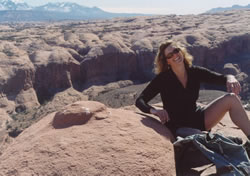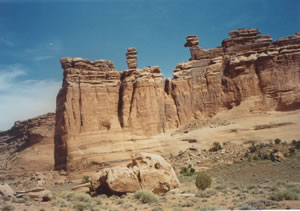Hiking Happenings December
2004
Walkabout with Rory
Tyler:
Sun Spots
 Enjoying the winter
sunshine
Enjoying the winter
sunshine |
Between the gaps of the
winter storm tracks diurnally inclined, protoplasmic, self-propelled
organisms; including, for example, iguanids, ungulates,
and ape-family bipeds with the expanded cerebral cortexes
(lizards, deer, and people); exhibit genetically induced
tropisms by seeking silicon oxide masses that are well-aspected
for solar collection and where Aeolian phenomena have minimal
impact. Or, simply put, rock walls that are out of the
wind can be pretty cozy on any sunny December day.
Hey,
no secret there! What a pleasure to amble along a warm
rock bench or to snuggle up to a toasty wall, nibbling
a yummy snack and enjoying the languid, wandering conversation
of an amiable companion. Or perhaps, simply drifting
along in a singular reverie in the secure keep of a sheltering
alcove. You know you’re not the first, even though it feels like
it. For thousands of years people here have been seeking
these sunny sanctuaries on chilly winter days. This is
the kind of place you’re likely to find the stone
chips, charcoal deposits, and rock art remainders of the
Ancients. There’s something comforting in the knowledge
that, with all the strange changes and peculiar stresses
that come along with the “blessings” of modernity,
there’s still something primitive and satisfying
about the way the heat from the stone soaks into your back.
There’s a biological contentment in simply turning
your face into the soft winter sun, closing your eyes,
and basking in the glory of light and love. And so I will
suggest, for visitor and resident alike, three pleasant
Sun Spots suitably situated for the archetypal edification
of this most pleasantly primal instinct.
 A warm rock wall in
Hellroaring Canyon
A warm rock wall in
Hellroaring Canyon |
CORONA ARCH
and CULVERT CANYON
A classic Navajo Sandstone Solar Collector (NSSC) and
a great morning warmer! The sun comes up early here
all winter. NSSC’s abound
but, bang for the buck, no place delivers so much with so little effort
as the trail to massively elegant Corona Arch. Drive north out of town,
cross the river, take the first left onto Potash Road and go 9.9 miles
to the trailhead. It’s a mile and a half to the arch and the
first third of that is cold and shady in the morning. Don’t be
fooled. Bring the shorts, the sunscreen, a gourmet picnic, a ton of
postcards, and your ukelele. Stop anywhere. It’s all good.
If you want to grease some miles, continue down Potash Road
another quarter mile to where a big culvert cuts under the
railroad track. “Park
and Walk” under the Culvert. You have entered the magic kingdom
of the Gold Bar Rim; the south-facing Kayenta Sandstone cap of the
Cane Creek Anticline. Wide, high, long and sunny all winter. Bear left
and up for two miles (but don’t cross any divides) and you’ll
get to magnificent Jeep Arch. Further strenuous efforts take you deeper
into the Gold Bar Rim and beyond…beyond….
| Cryptos
(krip’ tose): The surface of Moab’s
desert is held together by a thin skin of living
organisms known as cryptobiotic soil or cryptos.
It has a lumpy black appearance, is very fragile,
and takes decades to heal when it has been damaged.
This soil is a critical part of the survival of
the desert. The cryptobiotic organisms help to
stabilize the soil, hold moisture, and provide
protection for germination of the seeds of other
plants. Without it the dry areas of the west would
be much different. Although some disturbance is
normal and helps the soil to capture moisture,
excessive disturbance by hooves, bicycle tires
and hiking boots has been shown to destroy the
cryptobiotic organisms and their contribution to
the soil. When you walk around Moab avoid crushing
the cryptos. Stay on trails, walk in washes, hop
from stone to stone. Whatever it takes, don’t
crunch the cryptos unless you absolutely have to! |
CANE CREEK (again)
For an afternoon, I’ll direct your attention to Upper Moonflower.
Take Cane Creek Road about a quarter mile past Moonflower Canyon. A
dirt road goes up to the left. As soon as you crest that hill there
is a BLM 4x4 trail going left, along the majestic roots of the Behind
the Rocks fin complex. (There are some trailers up there, but well
away from the trailhead.) It’s your choice whether to stroll
along the easy the 4x4 road trail or snuggle up to the rocks for an
undulating slickrock sidle. (I’ve laid out a Frisbee Golf Course
here, but that’s another story.) The latter option, the warmer
choice by the byway, also offers some interesting opportunities to
discover several nice petroglyphs, including the impossibly-named and
ever-controversial Moab Mammoth. Intrepid walkers may continue around
the head of Moonflower Canyon and on to the high, sunny alcove a few
hundred yards beyond. Archeological cogniscenti will especially enjoy
this south-facing sanctuary.
WATERFALL
ALCOVE (Well, that’s
what I call it.)
This is more of a “local’s tip”, but for visitors with
gumption it’s well worth the effort. The walk includes three icy
stream crossings and a precipitous scramble up a steep slickrock incline;
not particularly dangerous but, for some, certainly thrilling. The Waterfall
Alcove is just above the waterfall in the Left Hand (or North Fork) of
Mill Creek. Ask someone how to find Powerhouse Lane, take it to the end,
go up the trail and stay left. (The Right Hand fork could certainly be
included in this discussion of Sun Spots, but I’m saving it for
my ‘spring flowers’ column.) The massive alcove is just above
the waterfall on the left, a mile or so from the trailhead. ( The word ‘alcove’,
according to Captain Sir Richard Francis Burton, is Arabic in origin
- al kube. Cf. scenes of Wadi Rum in “Lawrence of Arabia”.}
This amazing indentation is the perfect NSSC. The winter sun shines
in about 9 a.m. until around five in the afternoon. When it’s fifty
Fahrenheit in town it’ll be pushing 75 in the Waterfall Alcove.
Amazingly, the sun never shines into the alcove during the summer. It’s
cool and shady that entire season. The Ancients had this figured out,
or so one can assume from the intense concentration of petroglyphs and
pictographs there. Major habitation site. Why would I disclose such sensitive
information? Because I’ve personally run pot hunters out of there
twice. The more people of good spirit and good will who know about and
visit the Waterfall Alcove the less likely it will be looted and vandalized
any further. Oh, did I mention that the roof of the alcove is trimmed
by a lofty sweep of sandstone arch? Allah akbar! God is good to us.
Rory Tyler leads
custom rock art tours and backcountry hikes for people
of all skill levels for Canyon Voyages Adventure
Company. |

